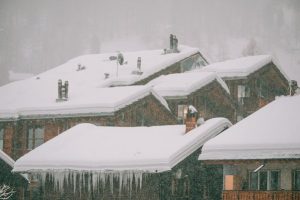Will Salt On My Roof Avoid Water Damage And Ice Dams?
 Even though rock salt is used heavily in winters when there are huge piles of snow, it has a damaging effect on your roof. Most homeowners know of the damage, yet continue to cut through the snow with it. It is because salt is a well-known and comparatively easier method to melt snow and prevent ice buildup. But will salt on your roof avoid water damage and ice dams? Certainly not!
Even though rock salt is used heavily in winters when there are huge piles of snow, it has a damaging effect on your roof. Most homeowners know of the damage, yet continue to cut through the snow with it. It is because salt is a well-known and comparatively easier method to melt snow and prevent ice buildup. But will salt on your roof avoid water damage and ice dams? Certainly not!
If you’re experiencing water damage and ice dams, 911 Restoration can cater to all your problems and offer you a speedy restoration process.
What Salt Does To Your Roof
We have established that even though salt on the roof helps to cut through ice and clear it out much easier than other options, it is still harmful.
Let’s look at all the reasons why:
It doesn’t work for all: Salt will only melt ice at temperatures as low as 20 degrees Fahrenheit, which means it works for areas where the temperature is on the warmer side yet freezing.
It has zero practicality: When melting ice dams with salt, one must remember that it is made of hundreds of gallons of frozen water, and can be extremely heavy. The amount of salt needed to melt that would be a lot, and that is unpractical.
Rusting: people use large amounts of rock salt on their roofs because they don’t think about their roof’s side effects. Thus, it leaves the nail heads on the roof to corrode, which can cause streaks and rust stains on the entire roof. In extreme cases, the nails can rust through and break, and leave your shingles unfastened and damaged.
It can ruin all the nearby areas: The salt that you very conveniently scatter along your roof and drop while clearing out your driveway, and front door passageway, ends up harming not just your roof but all these areas as well. As the salt starts pooling, by not pushing away the particles for a couple of days can result in the construction material eroding away.
It can destroy your garden plants: Once all the salt starts melting and mixing with water, whether it’s on the roof or the ground, it will become poison for your garden and plants (if you have one). While some plants are salt-tolerant, many are not, and the dangerous amount of salt in this ice is strong enough to kill the strongest of plants.
It can damage the masonry: As the melted water mixed with salt travels all through the brick walls, the salt particles can easily get in through the porous surfaces quickly. It is at a higher risk of damage when saltwater accumulates.
Removing Ice Dams Without Using Salt
Salt of any type is harmful as most of them have the same chemical composition. Trying to chip away at the ice dam with an ice pick, a hammer, or a shovel. You can slip, skid, or slide on the snow and fall off your roof.
In addition, chipping away with a pointy object will greatly damage your roof and shingles as they become brittle with the cold. Using these types of tools will make you easily fall into the snow and lose your balance.
The smart thing to do would be clearing off snow buildup from the ground, or a short-run ladder. A roof rake would do the job well in clearing out snow, and it will prevent the process of continuous thawing and freezing that results in ice dams’ formation. Do yourself a favor and fix the heating and insulation system in your home so that you have reduced thawing in winters.
If you are going to try out any homemade remedies to break off the ice dams, use de-icer – it is an effective method as it breaks the ice dams and allows water backed up behind it to drain out. Start by filling an old pantyhose with de-icer and placing them vertically on the ice dams perpendicular to the roof edge to crate the drainage channels.
There are other ways to prevent the formation of ice dams:
- A well-ventilated attic will help avoid ice dams. Keep one foot of free ventilation opening every 150 square feet.
- It is best to seal air leaks to prevent warm air leakage from ceiling fixtures, plumbing vents, attic hatches, etc.
- Insulate your attic floor to minimize the amount of heat rising into the attic from below
- Clear out your gutter of leaves and other debris so that there are no chances of an ice buildup
- Whenever you get your house re-roofed, make sure to get an ice shield under your shingles
- Roof rake will help out to clear the snow above the gutter – clean as much as you can so that there are no buildups in future
In extreme cases, one must always avoid doing these dangerous activities alone and hire professionals to deal with your concerns. When your home is being affected in these challenging times, 911 restoration offers emergency water damage restoration that will keep your home safe from future damage.
Contact 911 Restoration or call us at (719) 419-9770 for licensed, bonded, and insured services.



